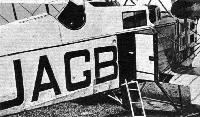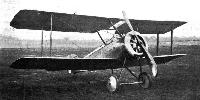Фотографии
-
Регистрационный номер: G-EAHT A Record Breaker: As announced in "Flight" last week, a Napiere engined Airco (DeH.) 9R, piloted by Capt. Gathergood, established a number of British records for speed on November 15, 1919. Our photograph shows the machine used for the flights. Capt. Gathergood, the pilot, is standing in front of the machine
Самолёты на фотографии: De Havilland D.H.9A - Великобритания - 1918
-
Three views of a four-engined Sikorsky biplane in flight
Самолёты на фотографии: Сикорский Илья Муромец - Россия - 1913
-
A 1,000-lb. bomb in front of a Sikorsky biplane
Самолёты на фотографии: Сикорский Илья Муромец - Россия - 1913
-
The Breguet seaplane
Самолёты на фотографии: Breguet Br.14 - Франция - 1916
-
The Farman "School" type biplane, which is also suitable as a three-passenger "Tourabout"
Самолёты на фотографии: Farman Farman-30/40 - Франция - 1915
-
The Farman School Machine: View of the nacelle
Самолёты на фотографии: Farman Farman-30/40 - Франция - 1915
-
Регистрационный номер: B9970 The first Kangaroo (B9970) with the original unsprung undercarriage and shallow front cockpit and two Rolls-Royce engines.
Самолёты на фотографии: Blackburn Kangaroo / R.T.1 - Великобритания - 1917
-
Регистрационный номер: K-130 THE AIRCO 16: This photograph shows the cabin of the standard machine which has been used extensively on the London-Paris air service. The Show machine is similar, except for the engine, which is a 450 h.p. Napier Lion
Самолёты на фотографии: De Havilland D.H.16 - Великобритания - 1919
-
The Airco (D.H.) 16, 450 h.p. Napier Lion
Самолёты на фотографии: De Havilland D.H.16 - Великобритания - 1919
-
The Farman Goliath: Side view
Самолёты на фотографии: Farman F.60 Goliath / F.169 - Франция - 1918
-
THE FARMAN GOLIATH: View inside the cabin
Самолёты на фотографии: Farman F.60 Goliath / F.169 - Франция - 1918
-
THE SPAD-HERBEMONT, TYPE S. 27, THREE-SEATER MONOCOQUE LIMOUSINE: It is fitted with a 300 h.p. Hispano-Suiza, and has a span of 32 ft., an overall length of 24 ft., and weighs, fully loaded, 2,772 lbs. It has a speed range of 65-143 m.p.h.
Самолёты на фотографии: Bleriot-SPAD S.27 - Франция - 1919
-
The Handley Page W 8, two 450 h.p. Napier Lions
Самолёты на фотографии: Handley Page H.P.18 (W.8) / H.P.30 (W.10) - Великобритания - 1919
-
Homing at Dusk. - the last flight of the day, on an Avro waterplane off Brighton
Самолёты на фотографии: Avro Avro 504 - Великобритания - 1913
-
Looping the loop, Norwich way, on the big Boulton and Paul machine
Самолёты на фотографии: Boulton Paul Bourges / P.7 - Великобритания - 1918
-
THE BOULTON AND PAUL "P 9"
Самолёты на фотографии: Boulton Paul P.6 / P.9 - Великобритания - 1918
-
The Boulton and Paul P 10: This machine is built entirely of metal, and should prove a great attraction at the Show
Самолёты на фотографии: Boulton Paul P.10 - Великобритания - 1919
-
The Boulton and Paul P 10, 100 h.p. Cosmos "Lucifer"
Самолёты на фотографии: Boulton Paul P.10 - Великобритания - 1919
-
One of two recent types of Avro biplanes: the "Limousine," which provides comfortable accommodation for three passengers, and has a speed range of 40-90 m.p.h.
Самолёты на фотографии: Avro 536 / 546 - Великобритания - 1919
-
Регистрационный номер: 1415 The first Blackburn G.P. seaplane, 1415, two Rolls-Royce engines, at the Isle of Grain in 1916.
Самолёты на фотографии: Blackburn GP - Великобритания - 1916
-
In 1915 appeared the "T.B." twin-fuselage seaplane with two 110 h.p. Clerget engines. It was originally designed for dropping steel darts.
Самолёты на фотографии: Blackburn TB - Великобритания - 1915
-
The Blackburn triplane scout. 100 h.p. Gnome Monosoupape. The singularly unsuccessful Blackburn fighter triplane intended for the anti-Zeppelin role.
Самолёты на фотографии: Blackburn Triplane - Великобритания - 1916
-
The Breguet C 2, type XVII, 450 h.p. Renault engine
Самолёты на фотографии: Breguet Br.17 C.2 - Франция - 1918
-
Регистрационный номер: C4298 THE BRISTOL PULLMAN: This machine has a cabin seating 14 passengers.
Самолёты на фотографии: Bristol Braemar / Pullman - Великобритания - 1918
-
THE BRISTOL PULLMAN: Photo shows one end of the cabin. Owing to lack of space on their stand, the Bristol firm are prevented from showing the actual machine, but a very fine scale model will be on view.
Самолёты на фотографии: Bristol Braemar / Pullman - Великобритания - 1918
-
The Bristol Pullman, four 410 h.p. Liberty engines
Самолёты на фотографии: Bristol Braemar / Pullman - Великобритания - 1918
-
Регистрационный номер: G-EAIZ THE BRISTOL TOURER: This machine is similar to the famous F2B, except that it has a Siddeley engine
Самолёты на фотографии: Bristol Tourer - Великобритания - 1919
-
The Bristol "Tourer," 230 h.p. Siddeley "Puma"
Самолёты на фотографии: Bristol Tourer - Великобритания - 1919
-
THE FARMAN SPORTING BIPLANE: Three-quarter front and three-quarter rear views
Самолёты на фотографии: Farman David / Sport - Франция - 1919
-
Three-quarter front view of the U.S. Navy HS-2L flying-boat
Самолёты на фотографии: Curtiss HS - США - 1917
-
Side view of the U.S. Navy HS-2L flying-boat
Самолёты на фотографии: Curtiss HS - США - 1917
-
Three-quarter rear view of the U.S. Navy HS-2L flying-boat
Самолёты на фотографии: Curtiss HS - США - 1917
-
U.S.NAVY HS-2L Flying Boat 330hp Liberty
Самолёты на фотографии: Curtiss HS - США - 1917
-
THE HENRY POTEZ, TYPE VIII: This machine has a 50 h.p. Potez engine
Самолёты на фотографии: Potez Potez VIII - Франция - 1919
-
Регистрационный номер: G-EAKI The Sopwith "Schneider Cup" racing seaplane, 450 h.p. Cosmos "Jupiter"
Самолёты на фотографии: Sopwith Schneider 1919 - Великобритания - 1919
-
The Sopwith "Gnu" three-seater limousine, 200 h.p. B.A.2
Самолёты на фотографии: Sopwith Gnu - Великобритания - 1919
-
THE WESTLAND LIMOUSINE: Three-quarter front view
Самолёты на фотографии: Westland Limousine - Великобритания - 1919
-
The Westland limousine, 275 h.p. Rolls-Royce Falcon
Самолёты на фотографии: Westland Limousine - Великобритания - 1919
-
The Blackburn Type "L" seaplane, 130 h.p. Salmson engine
Самолёты на фотографии: Blackburn Type L - Великобритания - 1914
-
An American de Havilland converted from a single to a multi-engined machine. The engines are two six-cylindered Libertys, one of which is capable of maintaining the machine in flight. It is being used, in conjunction with the Martin "bombers" for mail-carrying, and is said to be nice and easy on the controls.
Самолёты на фотографии: LWF J-2 / Twin DH - США - 1919
-
THE BRISTOL BABE: Photograph of the machine in skeleton form
Самолёты на фотографии: Bristol Babe - Великобритания - 1919
-
The Bristol Babe, 40 h.p. Siddeley engine
Самолёты на фотографии: Bristol Babe - Великобритания - 1919
-
The Bristol Racer, 450 h.p. Cosmos "Jupiter"
Самолёты на фотографии: Bristol Bullet - Великобритания - 1919
-
Регистрационный номер: F-JAGB The cabin of the Breguet limousine
Самолёты на фотографии: Breguet Br.18 Berline / Br.14T - Франция - 1919
-
THE HENRY POTEZ, TYPE S.E.A. IV P.M.: Three-quarter front view
Самолёты на фотографии: Potez SEA IV - Франция - 1918
-
The Sopwith "Dove" sporting two-seater, 80 h.p. Le Rhone
Самолёты на фотографии: Sopwith Dove - Великобритания - 1919
-
Регистрационный номер: G-EAJY A VERY SPORTY NIEUPORT SINGLE-SEATER: This machine is practically a modification of the "Night-hawk." It is said to possess a remarkable turn of speed
Самолёты на фотографии: Nieuport & General Nighthawk - Великобритания - 1918
-
THE AUSTRALIAN FLIGHT: On the left, the start from Hounslow of the Martinsyde 'plane on December 4. "Goodbye-ee!" At top: Mr. Nesbit of the Martinsyde firm wishes good luck to Capt. C. E. Howell on his journey. On the right: The Martinsyde 'plane gets away at 9.35 a.m.
Самолёты на фотографии: Martinsyde F.4A / F.6 / A - Великобритания - 1919
Статьи
- Flight















































